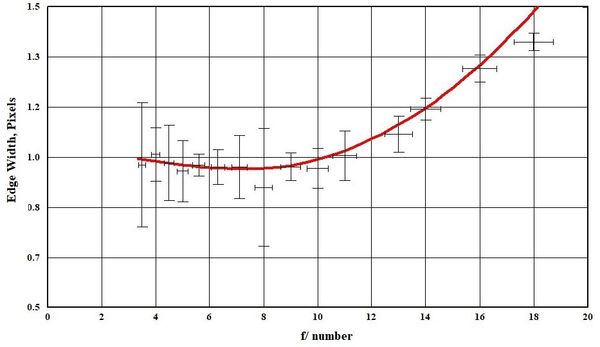Diffraction study
May 9, 2020 12:39:12 #
There have been a lot of things I wanted to look at over the past 50 years or so. Diffraction effects are one of them.
I started with this: https://www.uglyhedgehog.com/t-641034-5.html#11121069
Since I'm stuck indoors I tried to refine that measurement. The result was different, but not really significantly. But it now has error bars.
I started with this: https://www.uglyhedgehog.com/t-641034-5.html#11121069
Since I'm stuck indoors I tried to refine that measurement. The result was different, but not really significantly. But it now has error bars.
May 9, 2020 12:46:36 #
I read the PDF, and understood more of it than I expected to. But can you summarize your conclusions? From my reading, it looks like less of a problem than I would have expected.
Andy
Andy
May 9, 2020 13:12:09 #
AndyH wrote:
I read the PDF, and understood more of it than I expected to. But can you summarize your conclusions? From my reading, it looks like less of a problem than I would have expected.
Andy
Andy
My conclusion is that the sharpness will be best around f/8 (as expected), but degradation is relatively small out to f/16. Depends on what you call "small". 50% increase in edge width at f/18 isn't all that bad. It's about 1.5 pixels.
The primary purpose of the study was to fill time and write some graphing routines in Python.
Secondary objective was to try out uploading a PDF to UHH.
May 9, 2020 13:30:17 #
DirtFarmer wrote:
My conclusion is that the sharpness will be best around f/8 (as expected), but degradation is relatively small out to f/16. Depends on what you call "small". 50% increase in edge width at f/18 isn't all that bad. It's about 1.5 pixels.
The primary purpose of the study was to fill time and write some graphing routines in Python.
Secondary objective was to try out uploading a PDF to UHH.
The primary purpose of the study was to fill time and write some graphing routines in Python.
Secondary objective was to try out uploading a PDF to UHH.
DirtFarmer wrote:
My conclusion is that the sharpness will be best around f/8 (as expected), but degradation is relatively small out to f/16. Depends on what you call "small". 50% increase in edge width at f/18 isn't all that bad. It's about 1.5 pixels.
The primary purpose of the study was to fill time and write some graphing routines in Python.
Secondary objective was to try out uploading a PDF to UHH.
The primary purpose of the study was to fill time and write some graphing routines in Python.
Secondary objective was to try out uploading a PDF to UHH.
Looks like the difference between f/8 and f/16 is about a third of a pixel. (.95 to 1.28)
Mike
May 9, 2020 13:33:12 #
May 9, 2020 13:44:02 #
DirtFarmer wrote:
0.95 to 1.28 is about a 35% increase.
The difference between 0.95 pixels and 1.28 pixels is .35 pixels, or about a third of a pixel. Vanishingly small. Even zooming in to pixel level on an image and looking at an edge it is difficult to detect a difference that small.
Mike
May 9, 2020 14:12:53 #
Whew! A lot of work went into that paper. Of course the results are only for that lens. Other lenses may, and probably will, differ. I always test my lenses at every 1/2 f/stop. Most are sharpest at around f/9-f/11. However, I do have a couple lenses (Sony 35mm f1.8 and older Minolta 50mm f1.7) that are sharpest at much lower f/stops. I wonder if that affects when diffraction will occur?
May 9, 2020 16:02:55 #
SonyA580 wrote:
Whew! A lot of work went into that paper. Of course the results are only for that lens. Other lenses may, and probably will, differ. I always test my lenses at every 1/2 f/stop. Most are sharpest at around f/9-f/11. However, I do have a couple lenses (Sony 35mm f1.8 and older Minolta 50mm f1.7) that are sharpest at much lower f/stops. I wonder if that affects when diffraction will occur?
I think the more important result from that study is that in actual real world practice diffraction is not going to be a very serious concern.
Mike
May 9, 2020 16:06:39 #
Thanks for doing this. I am seeing this as related to sensor size, correct? So my distortion on a crop sensor camera would be a pixel or two greater, I can infer? Your graphs make the fall off very comprehensible. Thank you.
Can you also, in laymen's terms, explain why diffraction is not an issue on film cameras? I frequently shoot 35mm lenses on film at f22 or even below. And on one of my 4x5 cameras, the proverbial f 64 seems relatively diffraction free.
I'm slowing getting my head around this, but I'm still wishing I had paid more attention in physics class!
Andy
Can you also, in laymen's terms, explain why diffraction is not an issue on film cameras? I frequently shoot 35mm lenses on film at f22 or even below. And on one of my 4x5 cameras, the proverbial f 64 seems relatively diffraction free.
I'm slowing getting my head around this, but I'm still wishing I had paid more attention in physics class!
Andy
May 9, 2020 17:24:35 #
AndyH wrote:
Thanks for doing this. I am seeing this as related... (show quote)
The D7500 is a 20 MPx crop camera and the pixels have about 5 micron spacing, similar to my D800e. However, the lenses for an equivalent field of view are shorter for the crop camera so the physical aperture is smaller for the same f/ number. The diffraction is more a function of the physical aperture than the f/ number.
The D800e is pretty much the same sensor size as a 35mm frame so the results should be similar. Film grain is around 1-5 microns in size, while my D800e pixels are around 5 microns across. If film grain is 5 microns, the resolution would be around 10 microns using the Nyquist criterion. Fine grain film should be more like a high megapixel camera.
A 4x5 frame is so much larger that the lenses have to be that much longer to get the same field of view. So the actual aperture at f/64 is pretty much the same physical size as f/16 on the equivalent lens for 35mm. If you consider 4x5 to be full frame, 35mm is like a real crop camera.
May 9, 2020 17:34:02 #
DirtFarmer wrote:
0.95 to 1.28 is about a 35% increase.
1.28 pixel of a D800e? If so I have nothing to worry about when I use my 16MP Nikon Df. The lost due to diffraction is less than 1 pixel at f/22 right?
May 9, 2020 17:35:23 #
Blenheim Orange wrote:
I think the more important result from that study is that in actual real world practice diffraction is not going to be a very serious concern.
Mike
Mike
I would say that diffraction will not be really important until you get past f/22. At that point a 1-pixel image broadens to 2-pixels.
May 9, 2020 17:42:01 #
DirtFarmer wrote:
I would say that diffraction will not be really important until you get past f/22. At that point a 1-pixel image broadens to 2-pixels.
Agreed, and with the various lenses I use in actual comparison tests and then pixel peeping that was borne out. There is a lot that goes into the issue of perceived sharpness. Sometimes in close up work with wider apertures the subject appears to be very sharp because of the contrast with the out of focus elements behind it. In portraits, if the eyes are in focus the image looks sharp to people even though a lot of the face is very soft. That is not because the wider aperture is the sweet spot, necessarily.
Mike
May 9, 2020 18:10:21 #
In REAL pictures the composition and color balance is more important than the microsharpness.
May 9, 2020 18:18:09 #
If you can't see the difference, is it there?
Although this seems like a silly nothing comment, presenting a lengthy discussion and analysis without any of the actual images doesn't present much of anything. At a 35% difference in sharpness, we should be able to see this impact with the human eye as observed in the graphs. And yet, those actual images on which the graphs are based, at 100% pixel resolution, are missing from this presentation.
Although this seems like a silly nothing comment, presenting a lengthy discussion and analysis without any of the actual images doesn't present much of anything. At a 35% difference in sharpness, we should be able to see this impact with the human eye as observed in the graphs. And yet, those actual images on which the graphs are based, at 100% pixel resolution, are missing from this presentation.
If you want to reply, then register here. Registration is free and your account is created instantly, so you can post right away.




